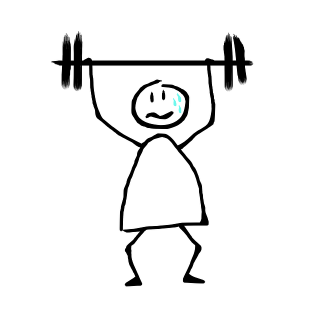Taryn Hayhurst, 2017
Experts in Australia suggest that an hour to two and half hours of high intensive exercise each week are recommended for adults wishing to maintain a healthy lifestyle (The Department of Health, 2014) with 56% of us being entirely inactive or not reaching these goals. As a community, we see getting physically fit as a great achievement to strive for, which is demonstrated by many of us centering our New Year’s resolutions around it. In 2016 alone, 54% of New Year’s resolutions were based on health and fitness in a poll of 1059 Australians, with 58% of all resolutions being broken throughout the year (Hassan, 2016).
Many of us will actively try to follow-through and sign-up to an exercise class or a gym. Why is it then that about 50% of us ultimately stop after six months or never actually try to begin with? (Dishman, 1988) What is stopping us from turning our intentions to be physically active into behaviour? Are intentions enough?
A very important consideration and predictor of whether intentions will transition into behaviours are the moderating factors upon this intention. That is, what are the other variables impacting upon our intentions? A meta-analysis by Rhodes and Dickau (2013) identified three main moderators that impact upon physical activity; Intention stability, Anticipated Regret and Conscientiousness. These are defined as the maintenance of intention across time, feelings of guilt or regret towards not participating in the behaviour and having self-disciplined/deliberate traits. Intention stability was found to be the most regularly occurring across multiple research articles. This suggest that if we maintain our intention to exercise at the same high level across time we are much more likely to be physically active (Paschal & Abraham, 2016).
Being able to maintain focus on one intention or goal at a time is also quite important in turning an intention into a behaviour (Kin-Kat & Chan, 2008). When we have confounding goals happening at the same time such as wanting to get fit, maintaining our high academic achievement, having a social life and trying to implement ‘me’ time, we will constantly be reprioritising. I don’t know about you but exercise falls to the bottom of the list more often than the others. This fluctuation of priorities affects our intention stability which we found moderate’s intention itself. Making sure exercise is a top priority consistently across time will improve our intentions to be physically active and ultimately commit to that behaviour.
Internal and autonomous processes are found to be effective in transitioning intention into behaviour in comparison to external factors. Within the study by Stanley, Cumming, Standage and Duda (2012) it was found that exercise imagery significantly affected intention and behaviour of physical activity. Specifically, imagining oneself as being super energetic and ready to get down and sweaty will increase our self-reported exercise behaviour. Similarly, if we imagine ourselves looking amazing and feeling healthier and perhaps stronger it will make our intentions to exercise stronger.
According to the Theory of Planned Behaviour we should be able to turn intention into behaviour as long as we believe the behaviour will make a positive contribution to our life, be socially or culturally favourable and be easily controllable (Rhodes, Macdonald & McKay, 2006). Instead of envisioning exercise as a chore or something that we can’t control because it might take up too much time or energy etc. we could try to adapt it into our lifestyle. Riding your bike to work instead of driving means you are saving on petrol and getting fit at the same time, doing it with a friend who already has been doing it for a while makes it socially favourable and finally its easily controllable as you can choose what days you decide to do it. Taking the dog for a walk, walking to the shops instead of driving, parking further away from work and then walking the rest of the way. With the help of the Theory of Planned behaviour, changing intentions into behaviour doesn’t have to be a chore.
If you have the intention to exercise and want to turn it into a behaviour, you should have a clear goal in mind and make it a priority. Surround yourself with people that also want to exercise, envision what you want to look like, how you want to feel and make it happen! Maintain the strength of your intention and make sure your goals are controllable i.e. achievable whilst also giving yourself internal guilt-inducing lectures when you do not follow through on your intentions. Conclusively, good intention alone may not be sufficient enough to change behaviour, but our attitudes, conflicts, perceptions and maintenance of our intentions could be the defining factors in committing to a behaviour or not.
References
Dishman, R. (1988). Exercise adherence research: future directions. American Journal of Health promotion, 3, 52-56.
Hassan, B. (2016). How to win at New Years resolutions. Press release new year’s resolution statistics 2016.
Kin-Kit, L., & Chan, D. K. (2008). Goal conflict and the moderating effects of intention stability in intention-behavior Relations: Physical activity among Hong Kong Chinese. Journal Of Sport & Exercise Psychology, 30(1), 39-55.
Paschal, S., & Abraham, C. (2016). Mediator of moderators: Temporal stability of intention and the intention-behavior relation. Personality and Social Psychology Bulletin, 29(2), 205 – 215.
Rhodes, R. E., & Dickau, L. (2013). Moderators of the intention-behaviour relationship in the physical activity domain: A systematic review. British Journal of Sports Medicine, 47(4), 215. Received from http://dx.doi.org/10.1136/bjsports-2011-090411
Rhodes, R., Macdonald, H., & McKay, H. (2006). Predicting physical activity intention and behaviour among children in a longitudinal sample. Social Science & Medicine, 62(12), 3146-3156. Retrieved from http://www.sciencedirect.com/science/article/pii/S0277953605006581
Stanley, D., Cumming, J., Standage, M., & Duda, J. (2012). Images of exercising: Exploring the links between exercise imagery use, autonomous and controlled motivation to exercise, and exercise intention and behavior. Psychology of Sport and Exercise, 13(2), 133-141. Retrieved from http://www.sciencedirect.com/science/article/pii/S1469029211001427
The Department of Health (2014) Australia’s Physical Activity and Sedentary Behaviour Guidelines for Adults (18-64).



Recent Comments